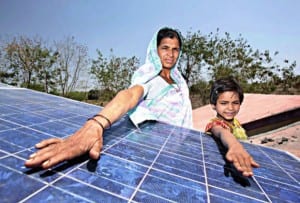 Sunny India is set to add more solar power than wind capacity for the first time this financial year. Solar installations are set to exceed 2,500MW this financial year (ending March 2016), topping the 2,400MW target for wind, according to officials from India’s Ministry of New and Renewable Energy.
Sunny India is set to add more solar power than wind capacity for the first time this financial year. Solar installations are set to exceed 2,500MW this financial year (ending March 2016), topping the 2,400MW target for wind, according to officials from India’s Ministry of New and Renewable Energy.
“By next year, solar installations will overtake those for wind by several fold,” Tarun Kapoor, a joint secretary in the ministry said last week. India is planning 100,000MW of solar installations by 2022, up from about 4GW currently.
Other countries in Asia have also seen a rapid expansion of their solar capacities.
Bloomberg New Energy Finance expects total solar PV build in 2015 to be between 55GW and 61GW in 2014, according to the latest Market Outlook. This is slightly higher than our earlier forecasts and takes into account the fact that the Chinese government “has been particularly aggressive in allocating new quotas for PV projects this year”.
Oversupply is still prevalent in the solar supply chain – from polysilicon to modules – resulting in tight margins, but many cell and module makers are now in the black. Shunfeng International said it would expand the solar production capacity of its Wuxi Suntech Power unit by at least 1GW. Shunfeng is looking at locations in North America and Southeast Asia either to build a new factory or to buy an existing one, chief executive Eric Luo said.
The addressable market for rooftop solar in Australia is probably greater than 5m homes, Origin, the country’s largest electricity and gas retailer, said in a presentation last week. The company aims to be Australia’s leading supplier of rooftop solar services and is actively pursuing the commercial solar segment.
In the US, another utility has been getting reading to offer solar panels and batteries. Southern Company’s Georgia Power Utility said it would start offering rooftop solar plants to homes from 1 July. It may also offer financing for residents to own the solar systems.
Solar panels are also getting erected over water reservoirs in California, Australia and Japan, though the cost of installation and maintenance tends to be higher. Kyocera and Century Tokyo Leasing have built three plants in Japan’s Hyogo Prefecture with a combined capacity of over 5MW. Solar Power, backed by China’s LDK Solar, is planning projects in the US and Mexico. Read the Bloomberg News story here.
Since the start of a feed-in tariff incentive programme in July 2012, Japan has added 15GW of solar capacity. To even the playing field with other renewables, its trade ministry is planning to cut solar incentives by 2017.
Japan is, meanwhile, planning to restart some of the nuclear plants shut down after the Fukushima disaster, with two reactors of Kyushu Electric expected to restart in August. In a white paper , published earlier this month, Bloomberg New Energy Finance projected that 12% of electricity would be generated by solar panels by 2030. This is much higher than the government’s estimate of 7%, which seems to assume that no renewables would be built without feed-in tariffs. The government expects 64GW of solar PV to be commissioned by 2030, while the BNEF estimate is more than 95GW. Details about our forecast for other technologies, as well as the reasons for the difference compared to the government estimates are explained in the paper.
In the storage sector, BYD started selling new portable power-storage units in Germany with a target of winning a third of the market there for such devices. It follows Japan’s Panasonic and Tesla Motors in offering these energy storage systems. LG Chem said it plans to supply its storage system for residential use to markets in Europe and Australia. Each residential storage unit has 12.8KWh of capacity. In a statement, Swiss battery manufacturer Leclanche said it would supply a 4.2MWh system for the world’s largest battery-operated ferry boat.
There was good news on the emissions front. Carbon dioxide emissions from energy use grew 0.5% in 2014 – the smallest increase for any year since 1998, with the exception of 2009, when emissions fell 1.5%, according to BP’s annual statistical review.
This is despite the high incentive to pollute – $115 per tonne of carbon dioxide – resulting from tax-breaks, subsidised fuel prices and other government support, according to the International Energy Agency’s Climate Change report.










